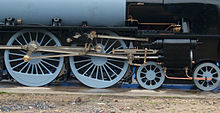Heusinger control
The Heusinger control or Walschaerts control is a type of steam engine control for locomotives.
History and dissemination
Edmund Heusinger von Waldegg invented the control in 1849. However, the Belgian Egide Walschaerts had the same principle independent of him in 1844, i.e. invented five years earlier, which is why this control is called Walschaerts control outside the German-speaking area.
The vast majority of European steam locomotives are equipped with this control. Further developments of the Heusinger control are the angle lever control and the Baker control, which is widespread in the USA .
functionality
construction
Instead of several eccentrics , a counter crank offset from the crank pin is attached to the drive shaft. From there a swing rod goes to the lower end of a backdrop with a fixed pivot point. This transfers the movement to the slide pushrod. The direction and the stroke of the slide pushrod can be adjusted by the position of the sliding block; if the sliding block is in the middle (i.e. in the axis of rotation of the sliding block), the rod does not move; the further the stone is deflected downwards or upwards, the more the slide push rod moves in the corresponding direction.
The lower end of the advance lever is moved by a rod (handlebar) from the cross head , the upper end by the slide push rod . In between, the advance lever is connected to the slide. Combined from the phase-shifted movements of the slide push rod and the handlebar, the direction and stroke of the slide result.
Aim and purpose
This construction essentially fulfills three objectives:
- Because the drive rod and slide rod move in opposite directions over a quarter turn, the position of the slide hardly changes due to the arrangement of the advance lever, so that it is possible for the filling quantity to remain at its maximum during this phase. This construction changes the movement of the slide rod, which essentially follows a sinusoidal oscillation, in the direction of a square oscillation. This keeps the slide fully open for a long time, which increases the efficiency of the drive.
- Since the direction of movement and the stroke of the push rod can be adjusted from the driver's cab using the control rod, the working direction of the steam cylinder can be controlled - and thus the direction of travel of the locomotive: forwards or backwards.
- The filling quantity of the cylinder can also be controlled by varying the distance between the rocker and the pivot point of the rocker.
Web links
- Heusinger control (drawing 62 positions) DGEG
- Steam locomotive science: Structure and technology of the DGEG steam locomotive
- Technical description TH EMT Eisenbahnmodelltechnik

